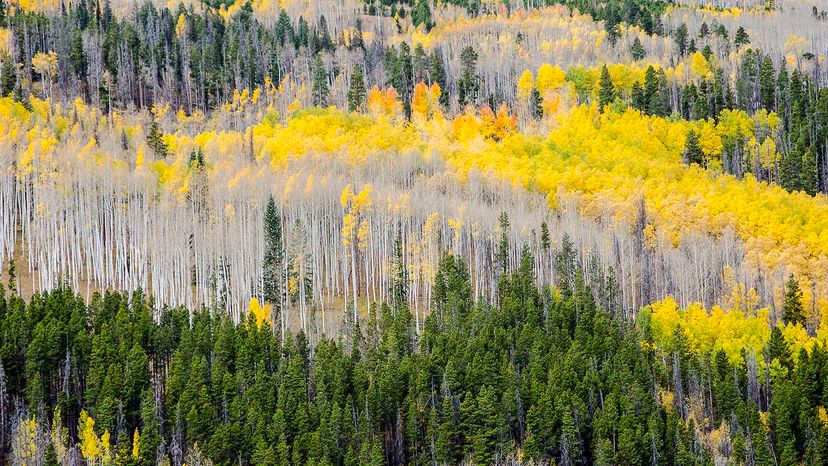 “Rows of golden aspen trees at their peak fall color are juxtaposed next to dark green spruce evergreens near Leadville, Colorado. bauhaus1000/Getty Images
“Rows of golden aspen trees at their peak fall color are juxtaposed next to dark green spruce evergreens near Leadville, Colorado. bauhaus1000/Getty Images
We’ve all seen those beautiful evergreen trees that seem to thrive during the colder months, steadfastly holding on to their brightly colored needle-like leaves as temperatures plummet.
On the other hand, the flat and wide leaves of their deciduous counterparts transform into brilliant shades of red, orange and gold during the chilly and dry days of fall and winter, only to eventually shed and leave the trees with barren branches.
So, why are evergreens — like conifers such as pines, firs, junipers and spruces — immune to seasonal leaf changes and shedding, while species of deciduous trees — like aspens, ash, birch, cherry, elm, oak, poplar and maple — aren’t? It mostly comes down to a little thing you might have learned about in biology class called photosynthesis.
Both deciduous and evergreen trees use energy from the sun and water from the ground to turn carbon dioxide in the air into food. The difference is that shorter days brings less sun during the fall and winter and that translates into less energy. So deciduous trees bearing broad, flat leaves go dormant (or into a hibernation mode) and shed their leaves to help them conserve water and stay alive until spring arrives and new leaves grow from new buds.
Evergreens, meanwhile, boast needles that are actually tightly rolled leaves, and this shape helps the needles conserve water throughout the fall and winter. A waxy coating on the needles also helps keep water from evaporating. These rolled-up, waxy needles resist cold and stay moist, which keeps them green throughout the winter.
Evergreens’ greater leaf longevity means they can survive in environments that don’t work for their deciduous cousins. In fact, evergreens can be found on every continent except Antarctica.
The bottom line: Although those colorful deciduous trees might attract their share of seasonal leaf-peepers, trees that stay green year-round have many appealing factors as well. Among their advantages: Evergreens add character to people’s yards during the fall and winter; offer shelter to birds and small animals when the weather is cold; and many species are dense enough to serve as windbreaks and privacy screens.
Lastly, they have a spectacular appearance, with some growing to an impressive size or displaying attractive hues.
NOW THAT’S INTERESTING
Evergreens actually do shed their needles, just not all at once. So, you might not even notice. As needles age, they turn yellow, brown or reddish tan and fall from the tree, but usually only a few at a time. The trees are constantly growing new needles, so they stay green year-round.


